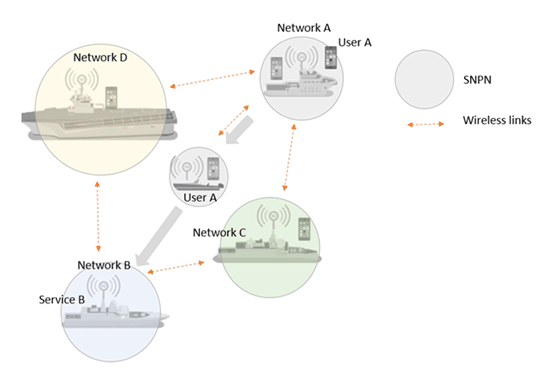Content for TR 22.848 Word version: 19.0.0
5.4 Use case on mobility in a group of interconnected standalone naval non-public networks
5.4.1 Description
5.4.2 Pre-conditions
5.4.3 Service Flows
5.4.4 Post-conditions
5.4.5 Existing features partly or fully covering the use case functionality
5.4.6 Potential New Requirements needed to support the use case
...
...
5.4 Use case on mobility in a group of interconnected standalone naval non-public networks p. 15
5.4.1 Description p. 15
This use case deals with self-organizing, broadband, low latency, connectivity solution between ships in a fleet. It is an extension of the use case 5.3 on interconnection of standalone naval non-public networks.
This network architecture, unusual in the world of public cellular networks, will however have to support all the mobility functions supported by terrestrial networks. In particular, a terminal will have to be able to move freely from one vessel to another, either in standby or while being actively involved in a communication. This movement should not be perceptible to the user.
The situation described in this use case is depicted on the Figure 5.4.1-1 below:

Figure 5.4.1-1: Example of mobility in a group of interconnected standalone naval non-public networks
(⇒ copy of original 3GPP image)
(⇒ copy of original 3GPP image)
5.4.2 Pre-conditions p. 15
User A terminal is loaded with a USIM that is registered to SNPN A.
SNPA A has local coverage on-board ship A and SNPN B has coverage on-board ship B.
Service B is offered by an application B hosted on ship B. Application B has 5G connectivity through SNPN B.
User A has needed credentials to access service B.
5.4.3 Service Flows p. 15
- User A on-board ship A and attached to the on-board SNPN A establishes a PDU session to access service B.
- User A takes a speed boat, equipped with necessary communication equipment to deploy locally SNPN around the speed boat and to enable connectivity with any vessels in the fleet through wireless links. Once it is deployed, the on-board SNPN selects the SNPNs in range, identifies and authenticates itself to those SNPNs. The SNPN on board the speed boat is then added in the group of interconnected SNPNs through wireless links.
- As the speed boat moves away from ship A, radio measurements made by user A terminal trigger the 5G system to handover the ongoing communication from SNPN A to the SNPN on-board the speed boat.
- At this point, user A terminal, although under radio coverage of the SNPN in the speed boat, keeps consuming service B through a communication path made of speed boat SNPN + SNPN A + SNPN D + SNPN B.
- Somewhere along the path from ship A to ship B, as radio conditions on the 5G link to ship A worsen and as the speedboat approaches ship D, the SNPN on-board the speed boat selects SNPN D as a new anchoring point to the group of interconnected standalone non-public networks. Based on the new resulting topology, the 5G system then seamlessly reconfigures the communication path from user A's UE to service B so that it can still continue to fulfil QoS required by service B. The communication path is now made of speed boat SNPN + SNPN D + SNPN B.
- Later on, as the speedboat approaches ship B, the on-board SNPN directly connects to SNPN B in the same anchoring point selection and communication path switching process as previously described to reduce communication latency.
- From the point in time user A gets on board the speedboat and gets to ship B, his communication with service B is maintained. There is no noticeable alteration of the communication along the path from ship A to ship B.
- When user A arrives at his destination on ship B, his communication is seamlessly handed over from the SNPN on-board the speedboat to one of the cells on SNPN B. Once connected to SNPN B, he can still access to service B and other local services according to authorizations he's entrusted with.
5.4.4 Post-conditions p. 16
User A is attached to SNPN B and still in communication with service B.
5.4.5 Existing features partly or fully covering the use case functionality p. 16
None
5.4.6 Potential New Requirements needed to support the use case p. 16
[PR 5.4.6-001]
Based on SNPN configuration and subject to SNPN operator's policy, the 5G system shall be able to support discovery, addition and authentication, or detachment of Standalone Non-Public Networks in a group of interconnected Standalone Non-Public Networks without interrupting ongoing communications.
[PR 5.4.6-002]
Based on SNPN configuration and subject to SNPN operator's policy, the 5G system shall be able to support service continuity of UE communications between interconnected Standalone Non-Public Networks with overlapping radio coverage.
[PR 5.4.6-003]
Based on SNPN configuration and subject to SNPN operator's policy, the 5G system shall enable packet loss to be minimized during mobility of a UE between interconnected Standalone Non-Public Networks with overlapping radio coverage for some or all connections associated with this UE.
[PR 5.4.6-004]
Based on SNPN configuration and subject to SNPN operator's policy, the 5G system shall minimize communication service interruption time during mobility of a UE between interconnected Standalone Non-Public Networks with overlapping radio coverage for some or all connections associated with this UE.